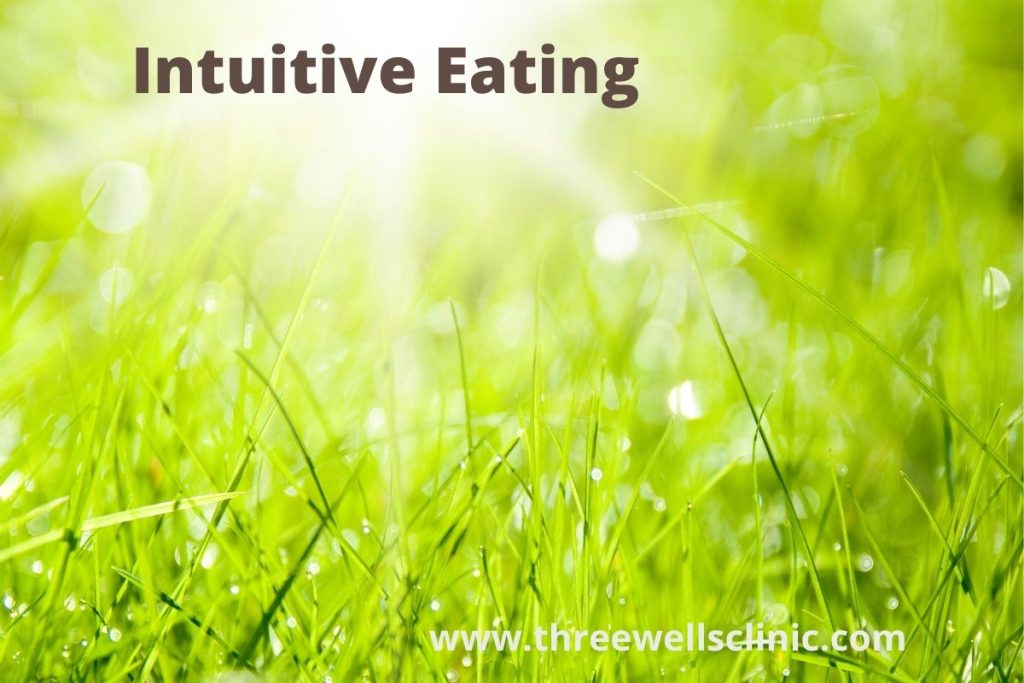Have you heard of intuitive eating?
I had come across it maybe 8-ish years ago and gave it a go – or so I thought. But I know now, all I did was make a new diet out of it.
I was trying to recognize hunger and fullness, yet keeping all of my existing food rules and restrictions. No surprise, it didn’t work and I gave up after a couple weeks.
That was so NOT intuitive eating.
It’s not a new diet. It’s not a “healthy lifestyle” or “clean living” wellness version of a diet.
It’s the most non-diet-y process I’ve ever come across and it’s helpful for anyone.
Now that I’m learning all the ins and outs of real intuitive eating (which includes UN-learning diet culture) and really following the process, it is a game changer.
Okay, so what is Intuitive Eating?
(I’ll abbreviate it IE for simplicity.)
IE was developed over 25 years ago by two registered dietitians, Evelyn Tribole RDN and Elyse Resch RDN, and there have been overwhelmingly positive research studies on it since then.
I HIGHLY recommend reading the book aptly named Intuitive Eating (get the 4th edition). A brief summary like I have below is just a teaser. The book has great explanations of each principle along with real-life examples.
My favorite summary of IE is from Lauren Cadillac, RD:
Intuitive Eating is a self-care eating framework designed to help you reconnect to the cues of your body. It is not a diet, or a set of rules to follow or to break. It is a set of 10 principles designed to help you reconnect to the wisdom you had at birth that got covered up by all the voices of diet culture and the rules we accumulated over the years.
The 10 Principles of Intuitive Eating
1 Reject the Diet Mentality
Hitting diet bottom. Being ready to be done with diets once and for all.
2 Honor Your Hunger
Learning the different types of hunger and how to recognize them. Learning where/when/how you might not be taking in enough energy.
3 Make Peace with Food
Giving yourself unconditional permission to eat. Learning to let go of Last Supper eating, guilt, and shame around food.
4 Challenge the Food Police
Firing the food police in your head who recite all sorts of food rules and judgments. Learning ALL foods are emotionally and morally neutral, neither good nor bad.
5 Discover the Satisfaction Factor
Learning how choosing pleasure and satisfaction in your foods plays a huge role in your health.
6 Feel Your Fullness
Practicing a pause in your meals and listening for cues of fullness.
7 Cope with Your Emotions with Kindness
Learning when it is, and is not, emotional eating. When it is emotional eating, practicing new ways to cope.
8 Respect Your Body
Learning you don’t have to love your body but you can give it the respect it deserves.
9 Movement – Feel the Difference
Finding joy and satisfaction in movement while no longer using exercise as a punishment or penance.
10 Honor Your Health – Gentle Nutrition
Making food choices and adding in foods that both taste good and feel good to you.
Click here to read more about each principle.
The Order of the Principles
You can approach IE any way you like but it is strongly recommended that principle 1 is first because if you feel you’ve got yet one more diet attempt in you, you won’t fully lean into practicing the new principles.
Principle 10 needs to be last. Once you have a handle on the previous 9 principles, then and only then, start adding back in gentle nutrition. If done too soon, it will ricochet you back into diet culture.
The middle principles can be added in any order depending on where you feel you need the most help first. There is a lot of overlap with the middle section where some can be practiced simultaneously.
Do you need additional help?
Intuitive Eating is for anyone and everyone. Many will do well just following along with the book and using the free resources online – there are tons and I’ll share more of them with you in the future.
If you have a medical condition where food management is one of the treatment recommendations, for example, diabetes, hypertension, some digestive and autoimmune conditions, you absolutely can do intuitive eating. But I strongly recommend that you also work with a registered dietitian who is specifically trained in Intuitive Eating, they can guide you through medical nutrition therapy.
If you have an eating disorder, intuitive eating can be a wonderful part of your healing. In addition to working with a registered dietitian trained in IE, I also strongly recommend working with a therapist who is also well versed in IE. It’s a powerful combination.
Focus on diet and exercise alone is almost always at the expense of our mental and emotional well-being. Intuitive Eating goes far deeper into helping people find peace with their relationship to food and to their bodies, and that is life-changing!
Do you feel like something is missing from the list of the 10 principles above? Click here to see what it is.
This post may contain affiliate links, meaning I may receive a commission (at no extra cost to you) if you use that link to make a purchase. See my disclaimer.
Is Three Wells right for you?
Get a free 15 minute Q&A consultation to find out!

